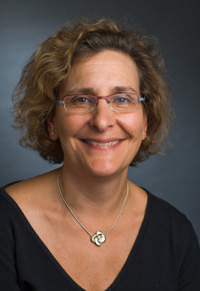September is Childhood Cancer Awareness Month. We asked Lisa Diller, MD, chief medical officer at Dana-Farber/Boston Children’s Cancer and Blood Disorders Center, to answer these important questions.
What signs might lead a child’s pediatrician to suspect cancer?
Cancer is very diverse, and diagnosis is further complicated because many signs and symptoms—like fever, bruising and headaches—are normal in healthy children.
Pediatricians are extremely skilled at distinguishing the usual bumps and pains from the concerning ones. They sense which symptoms truly need evaluation and astutely order tests based on the character, duration and severity of symptoms—and oftentimes their own instinct—to properly diagnose children.

What advice do you have for parents whose child has been diagnosed with cancer?
For most pediatric cancers, parents should remain positive. Cure rates have been steadily improving.
For instance, nearly 90 percent of children with standard acute lymphoblastic leukemia (ALL), the most common form of pediatric cancer, are cured with current therapy, and the long-term cure rate for Hodgkin lymphoma is 97 percent. The five-year survival rate for all childhood cancers combined is 83 percent, up from 58 percent in the mid-1970s. Many families have experience with cancer in elderly adult relatives, and it’s important to keep in mind the good prognosis in children.
Is it important to seek care from a pediatric facility?
Absolutely. Nearly all children in the United States with cancer are treated at a center specializing in pediatrics. The need for specialized pediatric pathologists, radiologists and surgeons in the diagnosis and treatment of pediatric cancers cannot be overstated. Brain tumor care is a great example: pediatric neurosurgeons, neurologists, neuropathologists and neuro-oncologists are skilled at diagnosing tumors, like medulloblastoma and optic glioma, which are rarely seen by our adult medicine colleagues.
What should a family expect if their child has cancer?
Let’s use leukemia as an example. Oncologists often receive a late afternoon call about a child seen in the office earlier that day whose complete blood count results suggest leukemia. We usually see these children in the emergency room the same day. Depending on the child’s state, they will either be admitted to the hospital for care, or seen in an outpatient facility. In either case, the patient will undergo preliminary tests, which may include scans, biopsies and blood work. This process may take several days; that time is sometimes necessary to arrive at an accurate diagnosis. A multi-disciplinary team of pediatric specialists, including an oncologist, surgeon, radiation oncologist, pathologist and radiologist, will evaluate the test results, make a final diagnosis and design a treatment plan. If a child is hospitalized during the diagnostic period or for treatment, a parent can usually sleep at their bedside.
At home, well-meaning relatives and friends often overwhelm parents. Families should be direct about what they do and do not need. When friends offer help, suggest they donate blood. Though donations may not directly benefit their child they care so much about, more blood will be available for other sick children. Many parents comment on how helpful neighbors and friends have been: caring for other children at home, making meals and driving visitors, including friends, to visit the patient.
What role does the child’s pediatrician play?
Primary care providers play a critical role before, during and after treatment for cancer. Pediatricians are the first to find abnormalities and recommend that parents consult a specialist. We see most of our patients after their pediatrician discovered something of concern, often during a well-child check. If a diagnosis of a malignancy is made, the pediatric oncology team provides most of the clinical care, but pediatricians assist with outpatient care by monitoring blood counts and nutrition levels or providing nursing support.
After treatment, children enter a two-year transition period during which the focus is on risk of recurrence and side effects of therapy. Pediatricians are an integral part of the child’s return to normal life, and a dialogue between oncologist and pediatrician is essential, especially around well-child care, growth and immunizations. Eventually, our focus changes from risk of recurrence to risk of late effects from treatment — screening becomes crucial for late effects of anticancer drugs and complications, including endocrine abnormalities, learning issues, secondary cancers or cardiac dysfunction.
Where should parents obtain information?
Rely on information available on the websites of reliable cancer institutes like the National Cancer Institute (NCI) and the American Society of Clinical Oncology. In fact, the NCI Web site offers brief overviews of the most updated therapeutic approaches. Parents and children can also visit the nearest medical facility offering cancer therapies to access books, videos and meet with resource specialist. The Dana-Farber/Boston Children’s Cancer and Blood Disorders web site also offers a lot of information that families may find helpful.
Lisa Diller, MD, is chief medical officer at the Dana-Farber/Boston Children’s Cancer and Blood Disorders Center. A pediatric oncologist with a special interest in neuroblastoma, she also studies the late effects of pediatric cancer.
